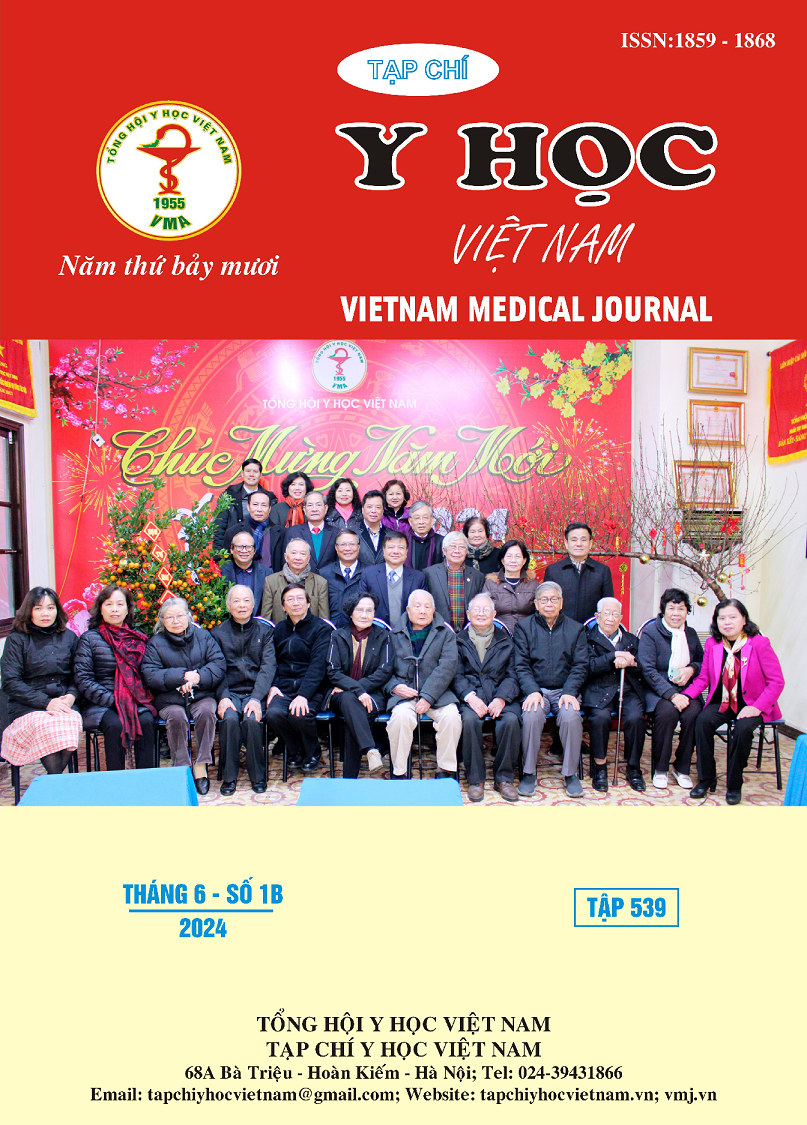SURGICAL TREATMENT FOR HEPATOLITHIASIS COMBINED WITH HEPATECTOMY AT HANOI MEDICAL UNIVERSITY HOSPITAL
Main Article Content
Abstract
Objective: The results of surgical treatment for hepatolithiasis combined with hepatectomy at Hanoi Medical University Hospital. Subjects and methods: A retrospective descriptive study was conducted at the General Surgery Department of Hanoi Medical University Hospital on a group of patients who underwent surgical treatment for hepatolithiasis combined with hepatectomy from 2018 to 2023. The content included clinical characteristics, laboratory findings, surgical techniques, and early outcome assessments. Results: A total of 125 patients participated in the study, with an average age of 56 years. The female-to-male ratio was 2.47. Abdominal pain was the commonest symptom, accounting for 72.8%. Most patients had normal liver function. The incidence of left hepatic atrophy on magnetic resonance imaging was 85%, and the rate of choledocholithiasis was 58%. Segmentectomy 2 and 3 due to hepatic parenchymal atrophy accounted for 88%, with an average operation time of 135 minutes and no intraoperative complications or blood transfusions. The postoperative morbidity was 10.4%, all classified as type I complications. Complete stone clearance was achived in 82% in the first month follow-up. Conclusion: Surgical treatment for hepatolithiasis combined with hepatectomy is safe and effective, with a low-mortality and a high stone clearance rate. It helps remove the affected liver parenchyma and drainage infected bile, also reducing the risk of recurrence and the development of intrahepatic cholangiocarcinoma.
Article Details
Keywords
Cholelithiasis, hepatolithiasis, cholangitis, hepatectomy, cholangiocarcinoma
References
2. Trần Bảo Long. Vai trò mổ mở trong điều trị sỏi đường mật hiện nay. In: Những Tiến Bộ Trong Chẩn Đoán và Điều Trị Sỏi Mật. NXB Y học; 2020:129-150.
3. Tsunoda T, Tsuchiya R, Harada N, et al. Long-term results of surgical treatment for intrahepatic stones. The Japanese Journal of Surgery. 1985;15(6): 455-462. doi:10.1007/ BF02470091
4. Feng X, Zheng S, Xia F, et al. Classification and management of hepatolithiasis: A high-volume, single-center’s experience. Intractable Rare Dis Res. 2012;1(4): 151-156. doi: 10.5582/ irdr.2012.v1.4.151
5. Wang W, Yang C, Wang J, Chen W, Wang J. Hepatolithiasis Classification Based on Anatomical Hepatectomy. Journal of Gastrointestinal Surgery. 2023; 27(5):914-925. doi:10.1007/s11605-022-05572-x
6. Clavien PA, Petrowsky H, DeOliveira ML, Graf R. Strategies for Safer Liver Surgery and Partial Liver Transplantation. N Engl J Med. 2007; 356(15): 1545-1559. doi:10.1056/ NEJMra065156
7. Jiang ZJ, Chen Y, Wang WL, et al. Management hepatolithiasis with operative choledochoscopic FREDDY laser lithotripsy combined with or without hepatectomy. Hepatobiliary & Pancreatic Diseases International. 2013;12(2): 160-164. doi: 10.1016/ S1499-3872(13)60026-0
8. Kim HJ, Kang TU, Swan H, et al. Incidence and Prognosis of Subsequent Cholangiocarcinoma in Patients with Hepatic Resection for Bile Duct Stones. Dig Dis Sci. 2018;63(12):3465-3473. doi:10.1007/s10620-018-5262-6
9. Bridgewater J, Galle PR, Khan SA, et al. Guidelines for the diagnosis and management of intrahepatic cholangiocarcinoma. Journal of Hepatology. 2014;60(6): 1268-1289. doi:10.1016/ j.jhep.2014.01.021
10. Pu T, Chen JM, Li ZH, et al. Clinical online nomogram for predicting prognosis in recurrent hepatolithiasis after biliary surgery: A multicenter, retrospective study. World Journal of Gastroenterology. 2022; 28(7):715-731. doi:10. 3748/wjg.v28.i7.715


